Body Rash on Baby That Comes and Goes
Many things tin crusade a rash in babies and children, and they're often aught to worry virtually.
As a parent, yous may know if your child seems seriously unwell and should trust your own judgement.
Rash with a loftier temperature
Rash on cheeks with high temperature
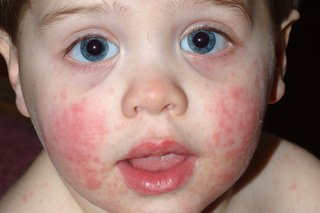
A rash on ane or both cheeks plus a high temperature, runny nose, sore throat and headache may be slapped cheek syndrome. Afterwards a few days, a rash may appear on their body.
Slapped cheek syndrome normally gets better on its own within three weeks. Children'south paracetamol or ibuprofen tin bring down a high temperature.
Blisters on hands and feet plus mouth ulcers
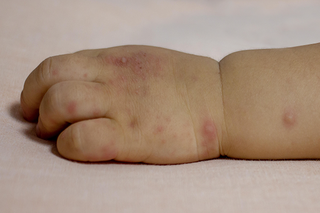
Hand, foot and mouth disease is a common childhood illness that causes blisters on the hands and feet, and ulcers in the mouth. It too causes a loftier temperature and your child may have a sore throat.
It usually gets better in seven to 10 days. Children's paracetamol tin bring down a high temperature.
Rash on the face and body
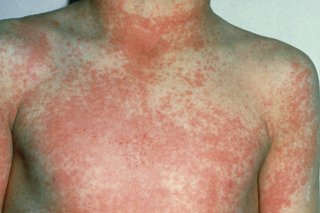
Cerise fever causes a rash that looks like pinpricks and feels crude, like sandpaper. The rash tin exist red, but this may be less noticeable on brown and black pare.
Scarlet fever normally starts with a white coating on the tongue, a sore throat, headache and a high temperature.
Run across a GP immediately if y'all recall your child has scarlet fever. It's treated with antibiotics.

Measles usually starts with the same symptoms as a cold, plus a high temperature, sore eyes that are sensitive to lite and gray spots inside the cheeks.
Subsequently a few days, a spotty rash appears on the head or cervix and spreads to the remainder of the body. The spots can appear cherry or brown, merely they may be less noticeable on brown and black skin.
Call a GP if you lot think your child has measles.
Rash with itching
Rash caused by heat

Heat and sweat can cause raised spots or patches known as prickly heat or oestrus rash. The rash tin can await red, but information technology may be less noticeable on brown or black skin.
Information technology itches, so you may observe your child scratching.
Heat rash usually gets better on its own later a few days.
Scaly or cracked peel
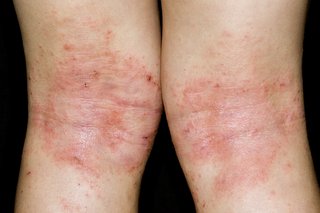

Peel that's itchy, dry and croaky may be atopic eczema. It's common backside the knees, elbows and cervix, but it tin appear anywhere.
The affected area may change colour. On white peel, the area may look pinkish or crimson. On brown and black skin, it may look grey or majestic, or darker than surrounding skin.
Speak to a GP if you lot think your child has eczema.
Raised, itchy spots or patches

Hives causes a raised, itchy rash. It can look red, simply this may be less noticeable on brown and black skin.
The rash can be a sign of an allergic reaction to things similar a sting, medicine or food.
It usually gets better within a few days.
Speak to a GP if your child keeps getting this blazon of rash. They may exist allergic to something.
Telephone call 999 if there's swelling around their mouth.
Itchy round rash
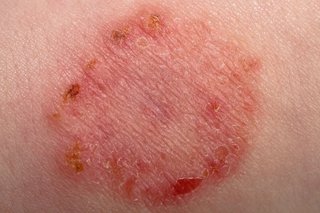
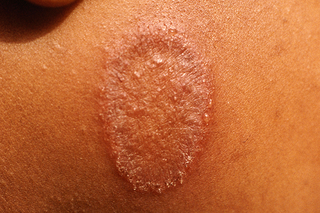
An itchy, dry, ring-shaped patch of peel may exist ringworm. The patch may look red, pink, silvery, or darker than surrounding skin.
Ask a pharmacist for a cream or lotion to treat ringworm.
Speak to a GP if information technology appears on your child'due south scalp, equally it may demand to be treated with prescription medicine.
Modest spots and blisters
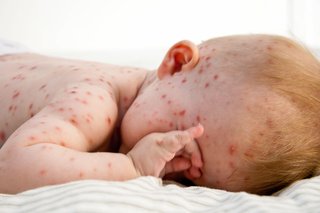

Chickenpox starts with pocket-size, itchy spots. The spots may look red, pinkish, the same colour or darker than surrounding skin, depending on your child's skin tone. At the kickoff, the spots may be harder to see on brownish and blackness skin.
The spots quickly form blisters and then scabs.
Some children take a few spots, while others accept them all over their torso.
Itchy sores or blisters
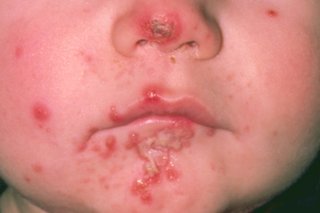
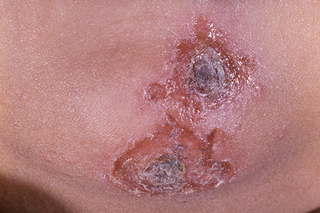
Reddish sores or blisters that burst and leave crusty, golden-brownish patches could be impetigo. The redness may exist harder to see on dark-brown and black skin.
The sores or blisters tin exist itchy, go bigger or spread to other parts of the body. They often appear on the face, hands or effectually the middle of the body.
Speak to a GP if you think your kid may have impetigo.
Tiny and very itchy spots

Scabies is acquired past tiny mites that burrow into the peel.
Ask a pharmacist for a foam or balm to treat scabies. Anybody in the household needs to be treated at the same time – fifty-fifty if they practise not have symptoms.
You should have your babe to a GP for advice if they are nether 2 months old.
Rash without fever or itching
Tiny spots on a babe's confront

Very modest spots, called milia, often appear on a babe'south confront when they're a few days old.
Milia may appear white or yellow, depending on your baby's skin tone.
They usually get abroad within a few weeks and practice not need treatment.
Red, yellow and white spots in babies
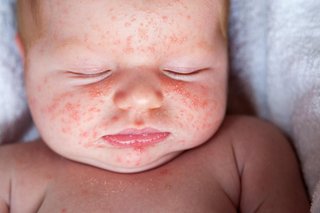
Raised red, yellow and white spots (erythema toxicum) tin can appear on babies when they're born. They usually appear on the face, body, upper arms and thighs.
The rash can disappear and reappear.
Information technology should become better in a few weeks without treatment.
Pink or skin-coloured spots
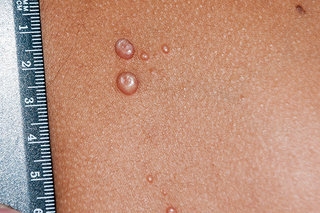
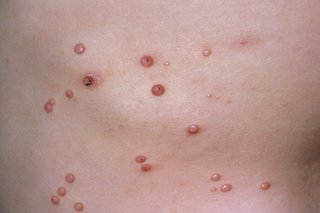
Small, firm, raised spots that tin can appear anywhere on the body are common in children and known as molluscum contagiosum.
The spots can exist the same colour as surrounding skin, darker than surrounding skin, or pink.
Handling is non recommended because the spots get ameliorate on their own, although it can take more than a yr.
Red patches on a baby's bottom

With nappy rash your baby'southward skin may look sore and experience hot. In that location may exist red patches on your babe'south bottom or effectually the whole nappy expanse.
There may be spots or blisters. It can make your child feel uncomfortable or distressed.
You tin can purchase cream from a pharmacy to help.
Pimples on the cheeks, nose and forehead
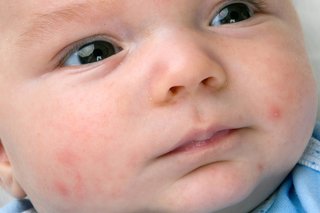
Baby acne can appear within a calendar month after birth but unremarkably gets better after a few weeks or months.
Washing your baby's face up with water and a mild moisturiser can help.
Practice not use acne medicines intended for older children and adults.
Yellow, scaly patches on the scalp
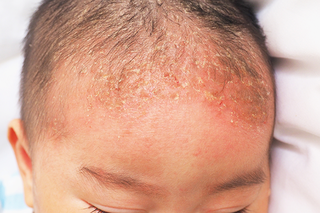
Cradle cap is when a baby gets yellowish or white, greasy, scaly patches on their scalp.
It normally gets better without treatment in a few weeks or months.
Gently washing your baby's pilus and scalp with baby shampoo may help prevent more patches.
Help u.s. meliorate
Tell us nigh your experience using health services.
Accept our survey
Page concluding reviewed: xi June 2021
Next review due: 11 June 2024
Source: https://www.nhs.uk/conditions/rashes-babies-and-children/
0 Response to "Body Rash on Baby That Comes and Goes"
Enregistrer un commentaire